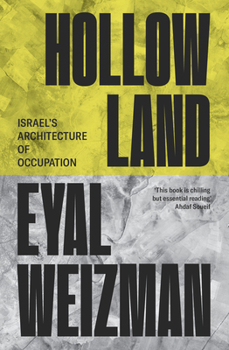Hollow Land: Israel's Architecture of Occupation
Select Format
Select Condition 
Book Overview
How does Israel extend its control over Palestinian lands? From the tunnels of Gaza to the militarized airspace of the Occupied Territories, Eyal Weizman unravels the mechanisms of control and how they have transformed Gaza and the West Bank into a war zone. This is essential reading for understanding how architecture and infrastructure are used as lethal weapons in the formation of Israel. In this new edition, Weizman explains how the events...
Format:Paperback
Language:English
ISBN:1804297100
ISBN13:9781804297100
Release Date:October 2024
Publisher:Verso
Length:368 Pages
Weight:1.82 lbs.
Dimensions:1.2" x 6.1" x 9.2"
Customer Reviews
3 ratings
Space, power and illusion
Published by Thriftbooks.com User , 16 years ago
Weizman begins his introduction by telling the story of the founding of Migron, a Jewish settlement built on Palestinian land in the West Bank. Convincing the Israeli military to build a cellular antenna, settlers first hire a single 24-hour guard. The guard is followed by his family, followed by five more families, and "by mid-2006 it comprised around 60 trailers and containers housing more than 42 families: approximately 150 people perched on the hilltop around a cellular antenna" (p. 2). But Weizman is not content to recite the facts of Israeli occupation. His analysis draws heavily on post-structuralist thinkers like Foucault, Deleuze and Guattari. Covering everything from Israeli architectural aesthetics, checkpoints and border terminals, to the Wall, Ariel Sharon's conception of depth security, Israeli urban warfare doctrine and targeted assassinations, he repeatedly penetrates the surface of his extensive empirical research, locating the social narratives which give birth to these phenomena. He is primarily concerned with charting what he calls the "elastic geographies" of the occupied territories (p. 5), a continually modifying frontier in which architecture and space become both a form of power and a conceptual way of understanding the political issues at stake. Some issues he tackles are well worn, but by combining his extensive fieldwork as a consultant for B'Tselem with a robust theoretical approach, he still brings interesting insight. In a series of chapters covering Israeli settlements, checkpoints and the construction of the wall, he exposes not just the extensive control of Palestinian society, but also the way in which Israel's sense of security has come to depend on a conception of the territories as a malleable and vulnerable space. The spread of these control mechanisms in Israeli society, he claims, constitutes a "cognitive and practical system that sees the physical separation of Jews and Arabs, and the total control of Palestinian movement, as an important component of Jewish collective security" (p. 155). Some of the issues, however, are less well known, such as his analysis of Israeli archaeology, architecture and landscape. He shows how city planning and architectural policies have attempted to make Jerusalem "an exhibition-piece of living biblical archaeology" (p. 29), drawing on Palestinians as "fossilized forms of biblical authenticity" (p. 43) while simultaneously seeking to reduce their contemporary presence. Weizman's strength is in the way he hits on two registers at once. His section on Jerusalem connects in a straightforward way with Israel's sustained attempts to minimize the Palestinian population in the city, and to visually and ideologically "unite" the Jewish suburbs with the historic city. But it also taps into the enduring manifestations of the contradiction between Zionism's secular modernism and its ancient biblical promise. Above all, "Hollow Land" doesn't just explain Israel's spatial practice
A new perspective on a familiar topic
Published by Thriftbooks.com User , 16 years ago
Hollow Land is very throughly researched and Eyal Weizman is clearly passionate about his topic. The book provides an interesting perspective on a widely discussed topic. The author is an Israeli, which gives him access and a through knowledge of the issues that many other authors lack. He is an activist and artist working on Israel-Palestine issues. He is also an architect, all of which gives him a unique perspective on the whole Israel-Palestine conflict. His descriptions of Israel's architecture of occupation shows his deep familiarity with the facts on the ground. His interest in architecture some times took the book in directions I was not interested in, such as the history of the selection of the architect for Ma'ale Adumim. However in general this provided a fresh perspective, and new information. The author clearly has strong opinions about his subject, but that does not interfere with the narrative. Hollow Land will interest anyone who cares about Israel-Palestine issues, as well as anyone interested in modern occupation. Hollow Land is also an example of a well written, throughly researched book that should server as a model for other authors.
Highly original, powerful
Published by Thriftbooks.com User , 16 years ago
Weizman's analysis of the articulation (division, consolidation, dimensionality, etc.) of space as a primary expression of political power is highly original in approach, full of extraordinary insights, and provides a powerful moral argument against the occupation of Palestine. While some writers theorize about this sort of thing, Weizman's application of highly refined ideas to concrete practices demonstrates a kind of eloquence and courage that is rare in discussions of Israel and Palestine. I think Hollow Land is an intellectual masterpiece.





